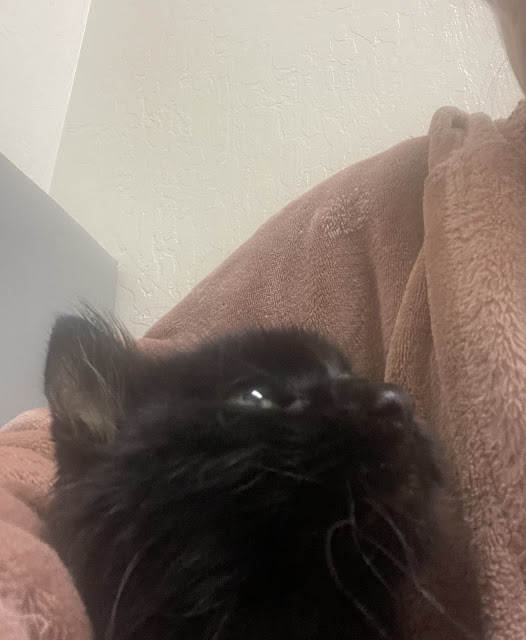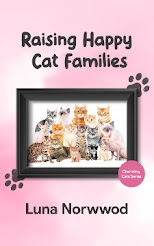Precerpt from Raising Happy Cat Families (Norwood): Integrating New Cats into a Family with a Dying Cat
Integrating New Cats When Older Cats Are
Dying
Integrating new cats into an established cat family is
always a delicate dance, but it becomes even more complex when one of the older
cats is nearing the end of life. The emotions in the household shift—grief,
vigilance, and quiet respect settle in—and the dynamics between the cats can
change in ways that are subtle, profound, or both.
In most cases, the cat who is dying has been part of
the family for many years, often serving as a social anchor. The newcomers, in
addition to finding their place among the living members, must navigate the
emotional space left by the one who is leaving.
Snyezhka, Happy Cat, and the Distance of
Newcomers
When Snyezhka was dying from breast, liver, and lung
cancer, it wasn’t the new cats who stepped in to care for her—it was Happy Cat,
her longtime companion and the beta heart of the household. Happy Cat washed
her when she could no longer groom herself, stayed close, and kept a faithful
watch by the door every time she left for her many vet visits, waiting
anxiously until she returned—until one day, she didn’t.
Happy Cat mourned. His demeanor changed. He searched,
he waited, and the light in his eyes dimmed. The newer cats, however, never
integrated with Snyezhka. They kept their distance, not out of cruelty, but
perhaps from an instinctive understanding that she was beyond their social
sphere. One of them, Bobolink, was himself ill and would pass away not long
after Snyezhka. He stayed close only to me, seeking comfort in the way some
sick cats do: by retreating from their own kind and leaning on their human.
The other cats, old and new, did not intrude. They
played with Happy Cat, the stable nurturer, but they gave Bobolink the space he
seemed to want.
Bobolink’s Passing: Solitude at the End
When Bobolink entered his final decline from multiple
fatal diseases, the same pattern repeated. The newer cats avoided him.
Bobolink, miserable and weary, didn’t mind. He no longer sought feline
company—just proximity to me, his safe place. Some cats, especially those in
pain, withdraw not only from play and activity but from social bonds
altogether. It is a quiet, private farewell.
The Death of Happy Cat: A Gentle
Transition
When Happy Cat himself began to fade—this time from a
brain tumor—the house held its breath. His decline was swift and disorienting:
circling, stumbling, confusion. We began crating him at night for his safety,
but the other cats, young and old, kept close watch. Even the newest arrivals,
who had not had time to form deep bonds with him, seemed to sense the shift in
the household.
And then, when Happy Cat could no longer hold the
center, Bear, one of our newest cats—large, mellow, peaceful—stepped forward
without effort or fanfare. Bear was no alpha, not even a beta, but he became
the quiet stabilizer. He didn’t lead so much as be, and the younger
cats, especially the newest rescues, gravitated toward him, following him,
resting near him, imprinting on him. His calm presence helped hold the family
together without struggle or dominance. It just was.
Nature Hates a Vacuum—Even in Cat Families
It seems that whenever one cat leader is dying,
another steps up. When Murjan, our gentle alpha, could no longer fill that role
and simply wanted sleep and my quiet company, it was Happy Cat who rose to the
occasion—stepping in as leader, but always in his soft beta way. And when Happy
Cat was dying, it was Bear who quietly took over—filling the gap not with
dominance, but with gentle companionship, in the way of a gamma cat who unites
others simply by “being” among them.
Especially the younger, newer cats—the ones still
finding their place—began to follow Bear, leaning into his steadiness the way
they once had with Happy Cat. It’s true what they say: nature abhors a vacuum.
And in the world of cats, at least in our home, someone always steps up—not
through force, but through presence.
The social fabric reshapes itself. The grieving
happens. And somehow, life continues, stitched together by the cats who remain.
🐾
Practical Tips: Integrating New Cats When an Older Cat is Dying
- Protect
the Vulnerable Cat.
- Ensure
the dying cat has quiet, safe spaces where younger or new cats won’t
disturb them. Soft bedding, easy access to litter, food, and water, and
minimal stress are essential.
- Don’t
Force Integration.
- New
cats may avoid the sick cat. This is normal. Let relationships develop
naturally—or not—without pushing closeness. Some dying cats prefer
solitude; others may welcome quiet companionship.
- Watch
for Caregiver Cats.
- Sometimes
a long-time companion will step into a caregiving role, grooming or
watching over the sick cat. Support these gentle interactions but
intervene if they become overwhelming for the ill cat.
- Expect
Emotional Shifts.
- The
social structure of the cat family may change as the dying cat’s role
fades. Grief, confusion, and even social withdrawal can occur in both
older and newer cats.
- Look
for the “Bridge” Cat.
- Often,
another cat—whether a nurturing beta like Happy Cat or a mellow gamma
like Bear—will quietly stabilize the group. Recognize and support this
cat’s role in holding the household together.
- Keep
Routines Steady.
- Cats
find comfort in consistency. Maintain feeding times, playtimes, and your
own interactions with all the cats to provide a sense of normalcy.
- Be
the Anchor.
- Many
sick or dying cats turn to their human for comfort. Spend gentle,
unhurried time with them. This closeness may also help new cats model
calm behavior.
- Honor
Grief—Theirs and Yours.
- Cats
grieve in their own ways. Some search, some withdraw, some become clingy.
Give them time and space to adjust to the loss. Be gentle with yourself,
too.
Learn more about cats. See our many Caturday posts.
Be entertained. See all our posts about cats.
Be inspired. See posts by and about Sula, parish cat, and her books.
Have a chuckle. Read posts by and about Jeremy Feig's award-winning book (book of the year finalist, Kops-Fetherling Lagacy Award for Humor), How My Cat Made Me a Better Man.
Watch for Luna Norwood's forthcoming book, Raising Happy Cat Families.
To purchase copies of any MSI Press book at 25% discount,
use code FF25 at MSI Press webstore.
Want to read an MSI Press book and not have to buy for it?
(1) Ask your local library to purchase and shelve it.
(2) Ask us for a review copy; we love to have our books reviewed.
VISIT OUR WEBSITE TO LEARN MORE ABOUT ALL OUR AUTHORS AND TITLES.
(recent releases, sales/discounts, awards, reviews, Amazon top 100 list, author advice, and more -- stay up to date)Check out recent issues.
Interested in publishing with MSI Press LLC?
Check out information on how to submit a proposal.
We help writers become award-winning published authors. One writer at a time. We are a family, not a factory. Do you have a future with us?
Turned away by other publishers because you are a first-time author and/or do not have a strong platform yet? If you have a strong manuscript, San Juan Books, our hybrid publishing division, may be able to help.
Planning on self-publishing and don't know where to start? Our author au pair services will mentor you through the process.
Interested in receiving a free copy of this or any MSI Press LLC book in exchange for reviewing a current or forthcoming MSI Press LLC book? Contact editor@msipress.com.
Want an author-signed copy of this book? Purchase the book at 25% discount (use coupon code FF25) and concurrently send a written request to orders@msipress.com.Julia Aziz, signing her book, Lessons of Labor, at an event at Book People in Austin, Texas.
Want to communicate with one of our authors? You can! Find their contact information on our Authors' Pages.Steven Greenebaum, author of award-winning books, An Afternoon's Discussion and One Family: Indivisible, talking to a reader at Barnes & Noble in Gilroy, California.MSI Press is ranked among the top publishers in California.
Check out our rankings -- and more -- HERE.



















Comments
Post a Comment